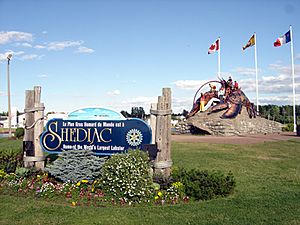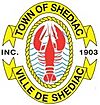Shediac facts for kids
Quick facts for kids
Shediac
|
|||
|---|---|---|---|
|
Town
|
|||

Entrance to the town
|
|||
|
|||
| Nickname(s):
Lobster Capital of the World
|
|||
| Motto(s): | |||
| Country | Canada | ||
| Province | New Brunswick | ||
| County | Westmorland County | ||
| Parish | Shédiac Parish | ||
| Founded | 18th century | ||
| Incorporated | 1903 | ||
| Government | |||
| • Type | Town Council | ||
| Area | |||
| • Land | 64.00 km2 (24.71 sq mi) | ||
| Elevation | Sea level to 33 m (0 to 108.3 ft) | ||
| Population
(2021)
|
|||
| • Total | 7,535 | ||
| • Density | 117.7/km2 (305/sq mi) | ||
| • Change (2016–21) | |||
| Time zone | UTC-4 (Atlantic (AST)) | ||
| • Summer (DST) | UTC-3 (ADT) | ||
| Canadian Postal code |
E4P
|
||
| Area code(s) | 506 | ||
| Telephone Exchange | 312 351 530 531 532 533 | ||
| NTS Map | 21I2 Moncton | ||
| GNBC Code | DACUC | ||
| Highways |
|||
Shediac is a lively town in New Brunswick, Canada. It is famous for its strong Acadian culture. Shediac is often called the "Lobster Capital of the World." This is because of its long history with lobster fishing.
The town is home to the popular Parlee Beach. Every July, Shediac hosts a big festival to celebrate its connection to lobsters. You can see a huge 90-ton sculpture called The World's Largest Lobster at the town's western entrance. It is believed that chiac, a special way of speaking Acadian French, got its name from Shediac.
Shediac has grown quite a bit over the years. In 2023, it expanded by adding parts of four nearby areas. New population numbers are still being worked out.
Contents
What Does the Name Shediac Mean?
Shediac was first known as La Batture. Its name changed to Shediac because of its location near the Shediac River basin. The name "Shediac" comes from the Micmac word Esedeiik. This word means "which comes from far away." It might refer to Shediac Bay or the strong current of the Petitcodiac river.
Where is Shediac Located?
Shediac is mainly found along Route 133. It sits around Shediac Bay, which is part of the Northumberland Strait.
The land in Shediac is mostly flat. Its soil is made up of rocks formed long ago during the Pennsylvanian period. Shediac has a typical continental climate, with warm summers and cold winters.
The town is located southwest of Pointe-du-Chêne. Pointe-du-Chêne was once an important travel hub. It was the end point for the European and North American Railway. It also served as a stop for large seaplanes, like those used by Pan-Am and Imperial Airways, for flights across the Atlantic Ocean.
A Brief History of Shediac
Hundreds of years ago, the Mi'kmaq had a major camp here called "Es-ed-ei-ik." This Mi'kmaq word means "running far in." It describes how the coastline turns in this area. Over time, this name changed to Gédaique.
Acadians first arrived in Shediac in 1751. They came here to escape problems in Nova Scotia. During the French and Indian War, a French officer named Charles Deschamps de Boishebert used Shediac as a base. He also stayed in Cocagne, New Brunswick. In 1755, Boishebert set up camp on the south shore of Cocagne Bay. The next year, he moved to Miramichi, New Brunswick. After the war, Acadians returned to the Shediac area in 1767.
Today, many francophones (French speakers) spell the town's name Shédiac. However, when the town officially became a town, the name was spelled Shediac, without the accent. This is still the official geographic name.
Shediac Bay Yacht Club
The Shediac Bay Yacht Club is a special place. It is listed on the 'Canada's Historic Places' register. This is because a local wharf has been located here for almost 100 years. The old Shediac Bay Yacht Club House was designed by a famous architect named Roméo Savoie.
How Many People Live in Shediac?
In 2021, the town of Shediac had a population of 7,535 people. These people lived in 3,293 homes. This was a 13.1% increase from its population of 6,664 in 2016. Shediac covers a land area of 64 square kilometers. This means there were about 117.7 people living in each square kilometer in 2021.
Population Growth Over Time
| Year | Population |
|---|---|
| 1901 | 1,075 |
| 1911 | 1,442 |
| 1921 | 1,973 |
| 1931 | 1,883 |
| 1941 | 2,147 |
| 1951 | 2,010 |
| 1961 | 2,159 |
| 1981 | 4,289 |
| 1986 | 4,370 |
| 1991 | 4,343 |
| 1996 | 4,664 |
| 2001 | 4,892 |
| 2006 | 5,497 |
| 2011 | 6,053 |
| 2016 | 6,664 |
| 2021 | 7,535 |
What Languages are Spoken in Shediac?
In 2016, most people in Shediac spoke French as their first language.
| Language | Population | Percentage (%) |
|---|---|---|
| French | 4,435 | 71.0% |
| English | 1,450 | 23.2% |
| English and French | 150 | 2.4% |
| Other languages | 215 | 3.4% |
Famous People from Shediac
Many notable people have come from Shediac or the surrounding area. Here are a few:
- Georges-Antoine Belcourt (1803–1874), a missionary
- Muriel McQueen Fergusson (1899–1987), a Canadian senator
- Gord Gallant (1950 – ), a professional hockey player
- Daniel Lionel Hanington (1835–1909), a former Premier of New Brunswick
- Pascal Poirier (1852–1933), a writer, lawyer, and senator
- Scott Pellerin (b. 1970), a former professional hockey player
- Albert James Smith (1822–1883), a former Premier of New Brunswick
- Elsie Wayne (1932–2016), a politician
Sister City
Shediac has a special connection with Breaux Bridge, Louisiana in the United States. They became sister cities in 1970.
Images for kids
See also
 In Spanish: Shediac para niños
In Spanish: Shediac para niños





